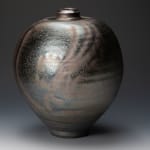Shimizu Uichi 清水 卯一 Japanese, 1926-2004
H28 × W24 × D20.8 cm
Further images
-
(View a larger image of thumbnail 1
)

-
(View a larger image of thumbnail 2
)

-
(View a larger image of thumbnail 3
)

-
(View a larger image of thumbnail 4
)

-
(View a larger image of thumbnail 5
)

-
(View a larger image of thumbnail 6
)

-
(View a larger image of thumbnail 7
)

-
(View a larger image of thumbnail 8
)

-
(View a larger image of thumbnail 9
)

-
(View a larger image of thumbnail 10
)

-
(View a larger image of thumbnail 11
)

-
(View a larger image of thumbnail 12
)

The Living National Treasure Shimizu Uichi’s famous metallic sheen via creamy iron-rich glazes decorate the surfaces of his functional vessels. Taking on a mantle dating back to the early practitioner of firing Chinese-style ceramics Ishiguro Munemaro (1893-1968), Shimizu continued to make use of iron-containing glazes while showing an unrestrained flair that he adopted in his later years. His stoneware vessels often showcase spirited finger-painted calligraphy featuring poetry that he writes himself.
Alongside Hayashi Yasuo, Shimizu Uichi was a part of the avant-garde ceramicist group “Shikokai 四耕社” in the Kyoto scene during the post-war period in the 1950s and 60s. The movement permitted potters to re-conceptualize pottery outside of industry traditions of Japanese ceramics, which had been dominated by the idea that lineage- rather, potters who were children of pottery masters- granted credibility to ceramicists. Shimizu’s frank boldness rippled through the ceramics world in Japan and created fresh aesthetic values, tenets, and precedents for what permitted a ceramic art object. Arguably the precursor to the well-known Sodeisha movement, the Shikokai movement questioned the traditions of Japanese ceramics. His awards speak for themselves: he has won Japan’s NITTEN exhibition, as well as placing second in the prestigious Japan Traditional Crafts Exhibition.











